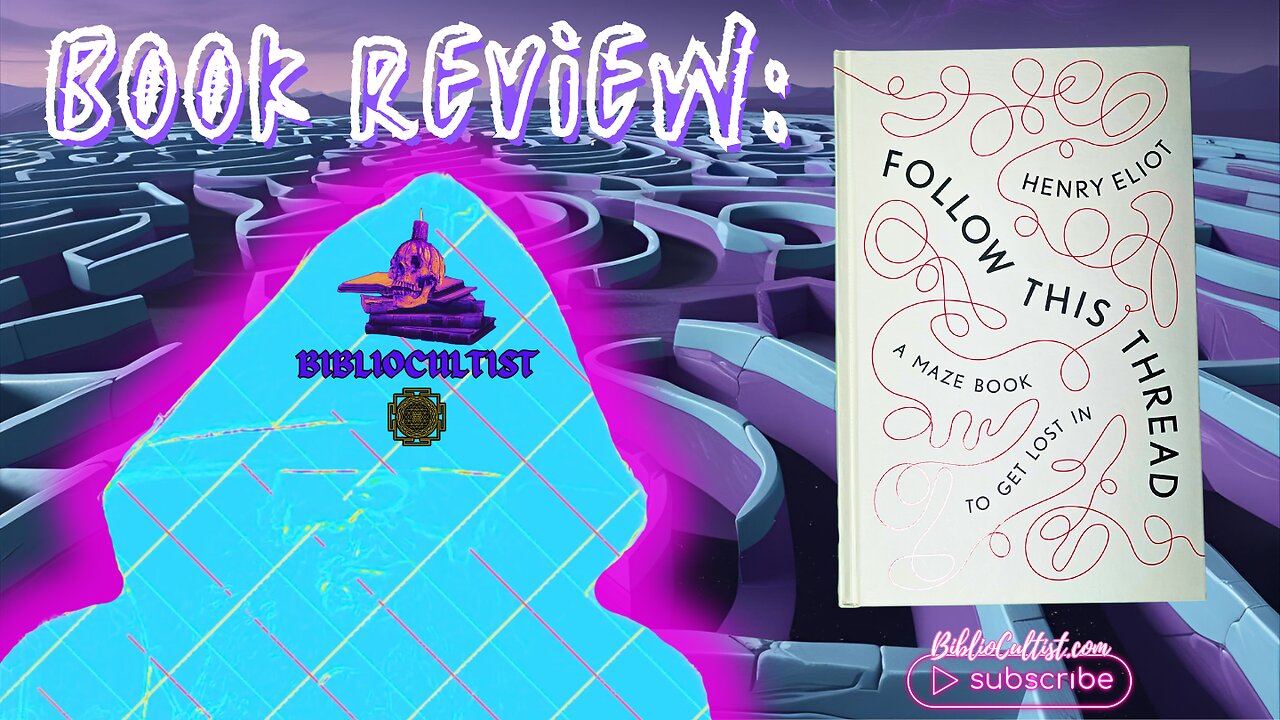Premium Only Content

Tangled Paths: Maze Symbology Unraveled
*CHECK OUT MY MERCH: https://bibliocultist.printful.me/*
In this thought-provoking #bookreview I delve into the captivating symbolism and hidden meanings woven throughout a fascinating book on the history and significance of mazes, as presented in Henry Eliot's "Follow this Thread". The book draws a compelling distinction between the single-path twists and turns of labyrinths and the deceptive dead ends of true mazes, tracing their origins from early designs by visionaries like Giovanni Fontana in the 15th century to the ancient Norse's use of labyrinths to entrap wandering spirits. But the true heart of this journey lies in pondering the profound metaphor of whether life itself is more akin to a labyrinth, with its singular path leading inexorably to a final destination despite the winding obstacles, or a maze, where the potential to become hopelessly lost on misguided paths looms ever-present. This existential quandary resonates with deep theological questions – the universalist belief that all roads ultimately converge on the divine versus the haunting possibility of eternal separation from truth and meaning. Fittingly, the book's unique formatting, with text rotating and shifting like the experience of navigating a maze itself, immerses the reader in a disorienting yet enlightening odyssey through the symbolic depths of these age-old constructs.
*all music and content copyright BiblioCultist.com*
#booktube #books #mazes #labyrinths #esoterica #symbolism #philosophy #theology #universalism #spirituality #biblio #cultist
**SHOW NOTES**
1. Henry Eliot is a British writer, editor, and creative polymath known for his innovative explorations of literary and visual culture. A former editor at Penguin Classics, Eliot combines erudition with playful ingenuity, as seen in his acclaimed book Follow This Thread—a whimsical yet deeply researched journey through the history, psychology, and symbolism of mazes, blending puzzles, mythology, and memoir. His work reflects a fascination with labyrinths as metaphors for life’s complexity, drawing on sources from Greek myth to Borges. Eliot also co-authored The Penguin Classics Book (2018) and curates literary walking tours, cementing his reputation as a modern guide to the intersections of text, art, and human curiosity.
2. Giovanni Fontana (c. 1395–1455) was a Venetian Renaissance polymath—engineer, physician, and alleged magus—whose esoteric manuscripts blended proto-scientific inquiry with occult symbolism. Trained in Padua, he designed hydraulic machines, cryptographic devices, and even "mechanical devils" (early automata), documented in his illustrated work "Secretum de thesauro experimentorum ymaginationis hominum" ("Secrets of the Treasure of Human Imagination"). Suspected of hermeticism, Fontana explored alchemy, memory arts, and illusionism, straddling the line between magic and nascent mechanics. His Bellicorum instrumentorum liber (1449) included war machines and fantastical inventions, hinting at a mind obsessed with transcending human limits—a legacy echoing later figures like Dee or Kircher.
3. Universalism, the belief that all souls will ultimately be saved and reconciled to God (apokatastasis), was controversially held by several early Christian thinkers—including Origen of Alexandria (3rd century), St. Gregory of Nyssa (4th century), and St. Isaac the Syrian (7th century)—who argued that divine love and justice would redeem even the damned.** Origen’s speculative theology, rooted in Neoplatonism, proposed that hell was purgative, not eternal, while Gregory saw salvation as the inevitable fulfillment of God’s goodness. Despite their sainthood, these ideas were later condemned as heresy (e.g., at the Second Council of Constantinople in 553), with the Church affirming eternal damnation as dogma. Yet, traces of universalism persist in mystics like Meister Eckhart and modern theologians, reflecting a tension between divine mercy and doctrinal orthodoxy.
4. The Chakra Vyūha (or Padmavyūha), a legendary spiral military formation from the Mahabharata, was designed as an impenetrable labyrinth of warriors, famously deployed by Dronacharya to trap Abhimanyu during the Kurukshetra war. Its origins trace to Vedic warfare strategies, symbolizing cosmic order (mandala) and chaos in battle. Abhimanyu, while still in his mother’s womb, had learned to breach the formation but not escape it—a fatal gap in his knowledge. Ancient texts like the Dhanurveda and later commentaries (e.g., Nilakantha’s Mahabharata exegesis) analyze its seven-tiered structure, comparing it to a lotus (unfolding layers) or a whirlpool (sucking foes inward). Escape required mastery of "vyūha-vidya" (formation science), involving precise footwork, directional shifts, and exploiting "weak gates" (like Abhimanyu’s attempted breach at the 6th tier). Modern scholars and military historians still study it as an early example of psychological warfare and tactical geometry.
-
 18:54
18:54
Bearing
1 day agoNew York COMMUNIST TAKEOVER 🚨 Zoran Mamdani’s Revolution 💥
3.12K65 -
 1:05:26
1:05:26
Man in America
1 day ago“Poseidon” Doomsday Sub, Microplastics & The War on Testosterone w/ Kim Bright
40.2K55 -
 12:15
12:15
Degenerate Jay
20 hours agoIs GTA 6 In Trouble?
226 -
 LIVE
LIVE
FyrBorne
14 hours ago🔴Battlefield 6 Live M&K Gameplay: Who's Hunting Who?
816 watching -
 LIVE
LIVE
Times Now World
5 days agoVladimir Putin LIVE | Putin rushes to help Maduro, sends Wagner Group | US-Venezuela News | Trump
117 watching -
 LIVE
LIVE
DynastyXL
4 hours ago🔴LIVE Slurp Man when? Lets PLAY with viewers
135 watching -
 1:12:46
1:12:46
Dialogue works
9 hours ago $1.55 earnedLarry C. Johnson & Col. Larry Wilkerson: Russia & Iran to Build a WAR SHIELD — China Just Stepped In
16.4K3 -
 9:03
9:03
MattMorseTV
20 hours ago $75.06 earnedTrump’s America First CALL TO ACTION.
100K114 -
 2:18:38
2:18:38
Side Scrollers Podcast
23 hours agoGTA 6 GETS WRECKED AFTER ANOTHER DELAY + India THREATENS YouTuber Over Video + More | Side Scrollers
148K16 -
 18:03
18:03
Nikko Ortiz
1 day agoEBT Meltdowns Are Insane...
42.2K82